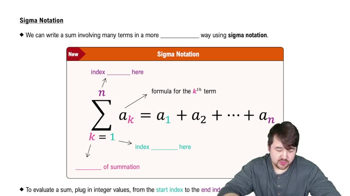Use the definition of a derivative, to find the derivative of the function at .
Table of contents
- 0. Functions7h 54m
- Introduction to Functions16m
- Piecewise Functions10m
- Properties of Functions9m
- Common Functions1h 8m
- Transformations5m
- Combining Functions27m
- Exponent rules32m
- Exponential Functions28m
- Logarithmic Functions24m
- Properties of Logarithms36m
- Exponential & Logarithmic Equations35m
- Introduction to Trigonometric Functions38m
- Graphs of Trigonometric Functions44m
- Trigonometric Identities47m
- Inverse Trigonometric Functions48m
- 1. Limits and Continuity2h 2m
- 2. Intro to Derivatives1h 33m
- 3. Techniques of Differentiation3h 18m
- 4. Applications of Derivatives2h 38m
- 5. Graphical Applications of Derivatives6h 2m
- 6. Derivatives of Inverse, Exponential, & Logarithmic Functions2h 37m
- 7. Antiderivatives & Indefinite Integrals1h 26m
- 8. Definite Integrals4h 44m
- 9. Graphical Applications of Integrals2h 27m
- 10. Physics Applications of Integrals 3h 16m
- 11. Integrals of Inverse, Exponential, & Logarithmic Functions2h 31m
- 12. Techniques of Integration7h 41m
- 13. Intro to Differential Equations2h 55m
- 14. Sequences & Series5h 36m
- 15. Power Series2h 19m
- 16. Parametric Equations & Polar Coordinates7h 58m
2. Intro to Derivatives
Derivatives as Functions
Problem 3.7.25d
Textbook Question
Derivatives using tables Let h(x)=f(g(x)) and p(x)=g(f(x)). Use the table to compute the following derivatives.
<IMAGE>
d.
 Verified step by step guidance
Verified step by step guidance1
Identify that you need to find the derivative of the composite function p(x) = g(f(x)) at x = 2, which is p'(2).
Recall the chain rule for derivatives, which states that if you have a composite function p(x) = g(f(x)), then the derivative p'(x) = g'(f(x)) * f'(x).
Evaluate f(x) at x = 2 using the table to find f(2). This will give you the input for g'.
Use the table to find g'(f(2)), which is the derivative of g at the point f(2).
Find f'(2) using the table, which is the derivative of f at x = 2. Multiply g'(f(2)) by f'(2) to get p'(2).
 Verified video answer for a similar problem:
Verified video answer for a similar problem:This video solution was recommended by our tutors as helpful for the problem above
Video duration:
2mPlay a video:
Was this helpful?
Key Concepts
Here are the essential concepts you must grasp in order to answer the question correctly.
Chain Rule
The Chain Rule is a fundamental theorem in calculus used to differentiate composite functions. It states that if a function h(x) is composed of two functions f and g, such that h(x) = f(g(x)), then the derivative h'(x) can be found using the formula h'(x) = f'(g(x)) * g'(x). This rule is essential for calculating derivatives of functions that are nested within each other.
Recommended video:

Intro to the Chain Rule
Derivative Notation
Derivative notation, such as f'(x) or p'(2), represents the rate of change of a function with respect to its variable. The notation p'(2) specifically indicates the derivative of the function p evaluated at the point x = 2. Understanding this notation is crucial for interpreting and calculating derivatives accurately.
Recommended video:

Sigma Notation
Function Composition
Function composition occurs when one function is applied to the result of another function. In the context of the question, h(x) = f(g(x)) and p(x) = g(f(x)) are examples of composed functions. Recognizing how to work with composed functions is vital for applying the Chain Rule and finding derivatives of such functions.
Recommended video:

Evaluate Composite Functions - Special Cases
Related Videos
Related Practice
Multiple Choice


